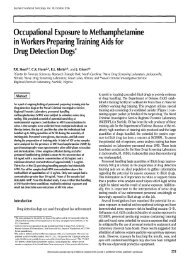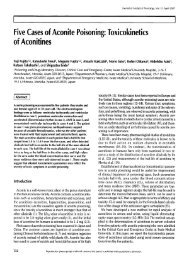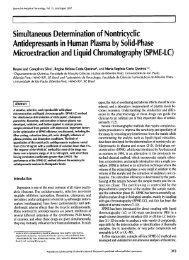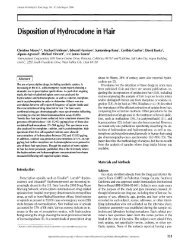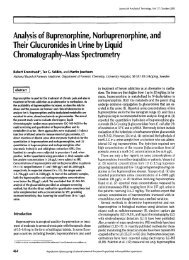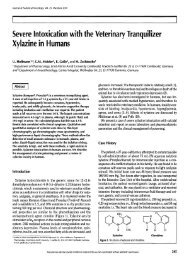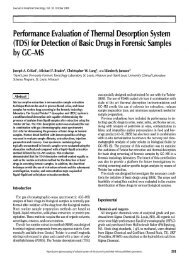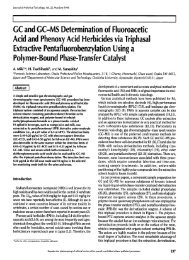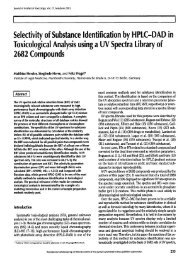Urinary Excretion Rates of Ketamine and Norketamine Following ...
Urinary Excretion Rates of Ketamine and Norketamine Following ...
Urinary Excretion Rates of Ketamine and Norketamine Following ...
Create successful ePaper yourself
Turn your PDF publications into a flip-book with our unique Google optimized e-Paper software.
Journal <strong>of</strong> Analytical Toxicology, VoL 28, July/August 2005<br />
(approximately 5 rain) followed by rinsing with 3 mL <strong>of</strong> deion-<br />
ized water, 1 mL <strong>of</strong> 0.1M HC1, <strong>and</strong> 3 mL <strong>of</strong> methanol. The<br />
column was dried under vacuum for 5 rain. The retained ana-<br />
lytes were eluted with a mixture <strong>of</strong> methylene chloride/iso-<br />
propanol/ammonium hydroxide (78:20:2, v/v) under gravity.<br />
The eluates were evaporated to dryness under a stream <strong>of</strong> air. In<br />
cases <strong>of</strong> analyte concentrations exceeding the upper level <strong>of</strong><br />
the respective calibration curve, the sample was diluted <strong>and</strong> the<br />
analysis was repeated.<br />
GC-MS-NCI analysis<br />
The dry residues were derivatized with 50 1JL <strong>of</strong> HFBA at<br />
60~ for 30 rain. After incubating, the excess derivatizing<br />
reagent was evaporated under air <strong>and</strong> the dry residue reconsti-<br />
tuted in 50 I~L <strong>of</strong> ethyl acetate before I IJL was injected into the<br />
GC-MS system.<br />
Quantitation <strong>of</strong> ketamine <strong>and</strong> norketamine was carried out<br />
using the Agilent Technologies 6890 series GC equipped with a<br />
5973 series mass selective detector (MSD) <strong>and</strong> a 6890 series au-<br />
tosampler (Agilent Technologies, Wilmington). The NCI mode<br />
was applied using methane as the reagent gas. The separation<br />
<strong>of</strong> analytes was performed with the use <strong>of</strong> a HP-5MS fused silica<br />
capillary column (30-m 0.25-mm i.d., 0.25-1Jm film thick-<br />
ness). The capillary inlet system was operated in the splitless<br />
mode. Instrumental conditions were as follows: injection port,<br />
280~ GC temperature program, 60~ for 1 min, ramp to<br />
310~ at 30~ <strong>and</strong> hold 3 min; transfer line, 280~ source,<br />
200~ quadrupole, 230~ The flow rate <strong>of</strong> carrier gas (helium)<br />
was I mL/min. The quantitative (underlined) <strong>and</strong> qualifier ions<br />
monitored for each derivatized compound were ketamine, m/z<br />
226, 357; norketamine, m/z 383 <strong>and</strong> 399; <strong>and</strong> norketamine-d4,<br />
m/z 387 <strong>and</strong> 403.<br />
LC-MS-APCI analysis<br />
The dry residue (after SPE <strong>and</strong> without derivatization) was re-<br />
constituted in 100 lJL <strong>of</strong> an acetonitrile (ACN)/water mix (1:4<br />
v/v). A 20-1~L sample was injected by autosampler into the<br />
LC-MS system.<br />
Analysis was performed with the HP-1100 series LC coupled<br />
to a MS equipped with an APCI interface (Hewlett Packard,<br />
Wilmington).<br />
The separation <strong>of</strong> analytes was performed with the use <strong>of</strong> a<br />
LiChroCART Purospher STAR RP-18e column (55- 4-mm<br />
i.d.) (Merck, Darmstadt, Germany) thermostated at 25~ The<br />
mobile phase consisted <strong>of</strong> 0.1% (v/v) formic acid in water <strong>and</strong><br />
ACN. The flow rate was 0.8 mL/min. All analyses were carried<br />
out in gradient mode: 0 min-10% ACN, 5 min-40% ACN, 6<br />
min-10% ACN, <strong>and</strong> 8 min-10% ACN.<br />
Nitrogen generated by a Whatman apparatus was used as a<br />
nebulizing gas. First, an autotuning procedure was carried out.<br />
Then optimization <strong>of</strong> MS parameters was accomplished by flow<br />
injection analysis to obtain the most intense ions for selected<br />
ion monitoring mode. <strong>Ketamine</strong> <strong>and</strong> norketamine at concen-<br />
trations <strong>of</strong> 100 ng/mL in mobile phase were individually injected<br />
directly into the MSD without chromatographic separation <strong>and</strong><br />
analyzed in full-scan mode (m/z range 50-500 ainu). For both<br />
analytes, the pseudomolecular ions <strong>of</strong> ketamine (m/z 238) <strong>and</strong><br />
<strong>of</strong> norketamine (m/z 224) were selected as the most repro-<br />
ducible <strong>and</strong> intense. Other parameters were as follows: frag-<br />
mentor voltage, 60 V; vaporizer temperature, 330~ capillary<br />
voltage, 4200 V; drying gas flow, 7 L/rain; temperature, 300~<br />
nebulizer pressure, 35 psi; corona current, 4.5 IIA. All data were<br />
acquired <strong>and</strong> analyzed by HP s<strong>of</strong>tware, ChemStation version<br />
A.06.03 for Windows NT.<br />
The calibration curves for ketamine <strong>and</strong> norketamine in urine<br />
consisted <strong>of</strong> 11 points for each compound, which covered the<br />
range <strong>of</strong> 0.5-2000 ng/mL. The calibrator solutions were pre-<br />
pared by adding known amounts each <strong>of</strong> the IS (ketamine-d4<br />
<strong>and</strong> norketamine-d4, 100 ng/mL each), ketamine, <strong>and</strong> norke-<br />
tamine to control urine (0, 0.5, 1, 2, 5, 10, 20, 100, 500, 1000,<br />
<strong>and</strong> 2000 ng/mL). The samples were hydrolyzed, extracted, <strong>and</strong><br />
analyzed by LC-MS-APCI in the same manner as described for<br />
the patients' urine samples. Peak-area ratios (ketamine/ke-<br />
tamine-d4; m/z 238/242 <strong>and</strong> norketamine/norketamine-d4; m/z<br />
224/228) were calculated for each st<strong>and</strong>ard <strong>and</strong> plotted against<br />
the known concentration <strong>of</strong> the st<strong>and</strong>ard.<br />
The method was validated by repetitive (at least three times)<br />
analysis <strong>of</strong> two different concentrations <strong>of</strong> spiked control urine<br />
samples containing 40 <strong>and</strong> 750 ng/mL <strong>of</strong> both target analytes<br />
(on the same day <strong>and</strong> over a period <strong>of</strong> three weeks).<br />
LOD, lower limit <strong>of</strong> quantification (LLOQ), <strong>and</strong> limit <strong>of</strong> lin-<br />
earity (LOL), as well as extraction recovery for ketamine <strong>and</strong><br />
norketamine (at concentrations <strong>of</strong> 40 <strong>and</strong> 750 ng/mL from<br />
spiked urine in comparison with unextracted drug solutions)<br />
were determined. Calculations were performed using Merck's<br />
Validation Manager Program.<br />
Results<br />
The GC-MS-NCI method (34) had an LOQ <strong>of</strong> 20 ng/mL for ke-<br />
tamine <strong>and</strong> 0.05 ng/mL for norketamine, <strong>and</strong> displayed a LOL<br />
across a concentration range <strong>of</strong> 20-1000 ng/mL <strong>and</strong> 0.050-1500<br />
ng/mL, respectively.<br />
The LC-MS-APCI method was characterized by the same val-<br />
idation parameters for both compounds: LOD <strong>of</strong> 0.5 ng/mL,<br />
LLOQ <strong>of</strong> 2 ng/mL, <strong>and</strong> LOL <strong>of</strong> 2-2000 ng/mL. Linear regression<br />
correlation coefficients <strong>of</strong> the calibration curves were 0.9997 for<br />
ketamine <strong>and</strong> 0.9999 for norketamine. Recovery <strong>of</strong> ketamine<br />
from urine was 107.86 3.66% at 40 ng/mL <strong>and</strong> 100.33<br />
1.87% at 750 ng/mL. Recovery for norketamine at the same low<br />
<strong>and</strong> high concentrations was 101.18 3.69% <strong>and</strong> 100.59<br />
1.75%, respectively. All values were high, but comparable <strong>and</strong><br />
reproducible. Coefficient <strong>of</strong> variations <strong>of</strong> the intra- <strong>and</strong> in-<br />
terassay precision did not exceed 4% for ketamine <strong>and</strong> norke-<br />
tamine at low concentration (40 ng/mL). These data for both an-<br />
alytes at the 750-ng/mL concentration were slightly lower. For<br />
ketamine the coefficient <strong>of</strong> variation was less than 2%.<br />
On the basis <strong>of</strong> the successful validation, both methods were<br />
applied to the determination <strong>of</strong> ketamine <strong>and</strong> norketamine in 62<br />
urine samples collected from six hospitalized children. <strong>Urinary</strong><br />
excretion pr<strong>of</strong>iles <strong>of</strong> ketamine <strong>and</strong> norketamine were presented<br />
in Figures 2-5 <strong>and</strong> Table I.<br />
After a single intramuscular ketamine dose, the drug was de-<br />
tected in the urine samples <strong>of</strong> five children. By the GC-MS-NCI<br />
379



